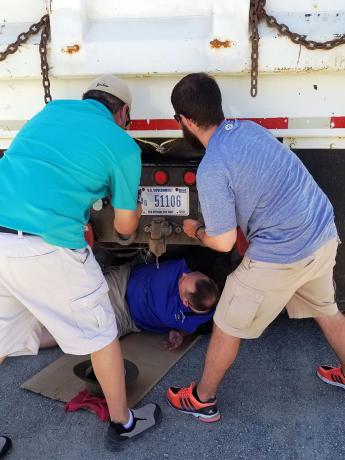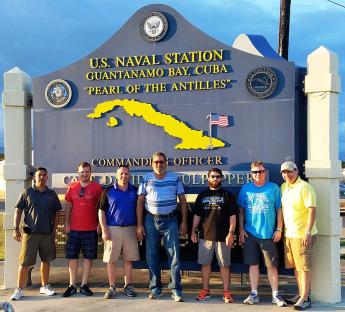San Juan FMC Doubles Inventory at GTMO with Vehicle Consolidation
By Alison Kohler
After months of preparation and coordination, three and a half days with long hours in uncomfortable weather conditions, and a team effort of seven GSA Fleet employees, the San Juan Fleet Management Center doubled its count of GSA Fleet vehicles from approximately 400 to 800 vehicles at Naval Station Guantanamo Bay, Cuba.

“The temperature was really hot, and from a person living in the Caribbean, I’ll tell you, it was hot,” said Javier Hernandez, fleet manager, San Juan FMC.
Despite a few challenges, the team successfully completed the mission to inspect and replace license plates on some 340 vehicles as part of a multi-year memorandum of understanding with Naval Facilities Engineering Command (NAVFAC) to consolidate more than 1,200 vehicles into the GSA Fleet program.
“Our (contiguous U.S.) customers pay us a monthly lease and mileage rate, and at Guantanamo it’s a monthly dry lease rate. They don’t pay a mileage rate, because of the location. They’re responsible for procuring their own fuel, maintenance, and transportation,” Hernandez said. “Going through Fleet, they don’t have to worry about fluctuating needs and funding availability because they pay our lease, and we take care of the procurement and purchase.”
As the forward, premier southern-most deep-water U.S. Naval Base in the Western Hemisphere, Naval Station Guantanamo Bay provides state-of-the-art self-sustaining infrastructure, while supporting unified, inter-agency joint operations, and training. NSGB is the oldest overseas U.S. military base, and the only one in a Communist country. Its nearly 6,000 residents include members of all military services, civilians from several U.S. government departments and agencies, and their dependents.
The lead-up to the trip to Guantanamo Bay April 2-5 involved months of planning and coordination across multiple agencies and geographic regions. The travelers were required to obtain the proper security clearance, get approval from headquarters, find a sponsor, and ensure compliance with GSA’s Foreign Travel Policy.
“It’s not easy to plan a trip like this one, and put all of the pieces together,” Hernandez said. “This is my fourth time visiting there. We went there in 2012, and we had a meeting with most of the tenants and possible customers. From that visit we have been increasing our participation and footprint over there as far as Fleet and getting more business since that visit.”
The team was comprised of seven GSA Fleet employees, Jon DiPasquale and Semeon Pogossian, who traveled from Washington D.C., Rene Cote from Hartford, Connecticut, and Joe Marsh from Atlanta, Georgia, and Luis Santana and Francisco Billoch in addition to Hernandez from San Juan FMC. NAVFAC also sent two members from Jacksonville, Florida, to help.

“I am very glad that we were able to complete the mission,” Hernandez said. “The hospitality and support by the local staff there was awesome. They’ve been outstanding and have given us support to complete the job every time.”
In addition to the long days and warm temperatures, the work was intense. Workers had to crawl under heavy equipment, remove rusted bolts, and inspect and process some vehicles that were approaching 15 to 20 years old.
Now the customers can enjoy rotation and replacement of vehicles around every three to seven years.
Although technology, including the FMS2GO app, is typically a valuable tool to manage the data collection and cataloging of vehicles and information, the cellular network there was unreliable, so the employees had to manually upload the information upon their return.
With more than 1,700 vehicles in the San Juan FMC inventory, a team of four employees provides support to 200 customers and 200 vendors to process safety recalls, order parts, provide technical assistance from the manufacturer and answer other customer needs within Puerto Rico, the U.S. Virgin Islands, Bahamas and Naval Station Guantanamo Bay, Cuba, Hernandez said.
“We have a commitment to provide high quality vehicles to our customers. We offer automated tools for agencies to better manage and control their fleet, and we’re committed to providing them with the right vehicle and the best service,” Hernandez said.

 U.S. General Services Administration
U.S. General Services Administration